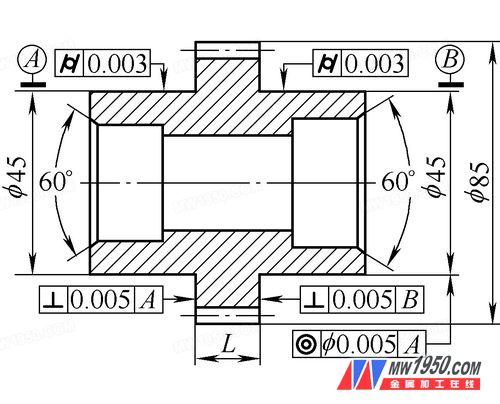Processing of new material aero engines and their key components
Aeroengine components are operated under the harsh environment of high temperature, high pressure and high speed. With the continuous updating and upgrading of aero-engine technology, more and more composite materials are applied to new engines, and a large number of aerospace engine components are adopted. High-strength high-temperature resistant alloys, powdered alloy steels, single crystal alloys, and lightweight high-strength composite materials add difficulty to the cutting process and put forward higher requirements for processing technology. Nickel-based superalloys are widely used in the aerospace industry. They have a series of advantages such as oxidation resistance, high temperature deformation resistance and good welding performance. They are suitable for manufacturing high temperature bearing parts and hot end parts of aerospace engines that work for a long time below 650 °C, but Due to the problems of many hard spots, extremely poor thermal conductivity, and large work hardening tendency, it often restricts on-site processing. Domestic and foreign scholars have carried out many researches on the cutting of superalloys. However, there are few researches on the processing parameters selection, tool selection and tool wear of various coated tools in the processing of nickel-based superalloys, which makes the on-site processing very difficult. The parts are shown in Figure 1. The material is GH2132, the parts are f10mm×2 000mm, the hardness is 320HBS; the batch is 500 pieces/month; the surface roughness value Ra=1.6μm is required after the parts are processed, and the product aspect ratio is 18, which is typical. Slim shaft parts. In the absence of a central hole, the conventional CNC lathe obviously can not meet the processing needs, and finally chooses the CNC vertical slitting automatic lathe CKN1120IV produced by Sichuan Pushinjiang Machine Tool Co., Ltd., in view of the processing characteristics of nickel-base superalloy and the special processing of processing equipment. In the way, through the cutting test results and analysis, the following conclusions are obtained: 1 The hard coated blade MT09T304-PM5-WSM30 is suitable for the processing of nickel-based superalloy. 2 processing nickel-base superalloy GH2132 blade, the main declination is generally selected 40 ° ~ 50 °, the secondary declination is generally selected 0.5 ° ~ 3 °, the blade inclination is generally selected -10 ° ~ -20 °, not easy to appear built-up edge Can guarantee the surface quality of the parts. 3 The cutting speed is preferably 95 to 120 m/min, and the feed amount is preferably 0.1 to 0.15 mm/r, and the surface roughness value Ra = 1.6 μm or more can be secured. The oil pump gear is one of the important hot end parts of the engine. Its working conditions are extremely demanding. In order to ensure the reliability and stability of the aero engine, for the materials of this part, the developed countries in Europe and the United States use powdered high-temperature alloy steel, which is evenly organized. The grain size is small, there is no obvious segregation, the degree of alloying is high, and the fatigue resistance is good. It is the material of choice for high-pushing engine gears, turbine disks and other components. When the high-vanadium powder metallurgy alloy steel of AHP-10V is ground, the roughness of the parts and the cracks generated by the grinding end face have always been one of the problems that plague the on-site processing. The parts are shown in Figure 2. The material AHP-10V, the surface hardness of the parts is ≥65HRC, and the center hardness is 30~45HRC. After the grinding process is completed, the roughness value of all external surfaces is guaranteed to be Ra=0.1μm, which meets the requirements of the drawings.
It is composed of 3 levels. The upper level and the lower level are Woven Geotextile and non woven textile. The middle level is bentonite grains, which are carefully selected from Liu Fangzi crude and filled in between the two levels after special processing.
Product characters:
Its waterproof properties are much more durable than that of the buildings. Sodium bentonite would transform to high density septum under hydro pressure. When The thickness is 3mm, the permeability is below a×10-11/sec(a=1~9), which equals to the density of 100 times of the clay with 30 mm thickness. Water retention performance is evident.
Geosynthetic Clay Liner (GCL) Geosynthetic Clay Liner Gcl, 3D Levels Gcl, Sodium Bentonite Gcl Feicheng Lianyi Engineering Plastics Co., Ltd , http://www.lianyigeosynthetics.com
Xi'an Aviation Power Control Company Zhao Xinglong 1. Processing of nickel-based superalloy parts

Figure 1 Slim shaft parts 2. Processing of powder superalloy parts

Figure 2 Parts to be processed
1. Environment friendly
GCL is made of natural raw materials of sodium-bentonite. It is raw and natural materials,;aging and corrosion seldom happen. It can keep its quality and then it does not cause any injuries and pollution for human and the environment. It is not only waterproof, but also has good ventilation performance. It can stick up for the exchange of the ecological environment. It is a pure natural, new, green waterproof material.
2. Permanent waterproof, excellent performance
Natural sodium bentonite was formed billions of years ago.
3. Easy to construct
Bentonite powder, nails and washers are enough for connection and fixation. Construction is not constrained by weather conditions and it could be taken under cold or wet conditions. Bentonite powder is spread on overlap point. When water comes, GCL would be overlapped automatically. It is so far the only material that starts the waterproof effect by water in the world. It is not necessary to take additional examination when the construction is completed. The repair works are easy in case of waterproof defects. Among the existing waterproof materials, GCL`s construction period is the shortest and its operation is the easiest. It has an eminent effect on shortening the construction period as well as saving the cost.
4. Strong Self-Restore Capacity
The integration between waterproof material and its target enables GCL a 20~28 times swelling volume. Even if concrete structure trembles or subsides, the bentonite in GCL would restore the crack of 2mm or below on the concrete structure immediately. Even if the diameter of perforation reaches 30 mm, the restoration will be finished within 15 days completely.
